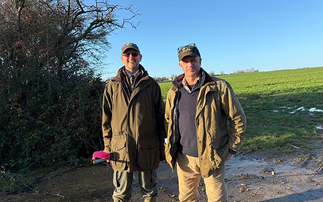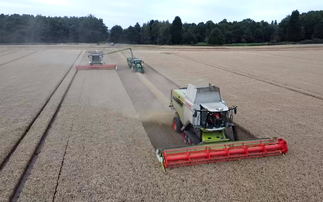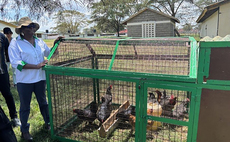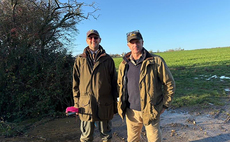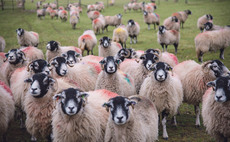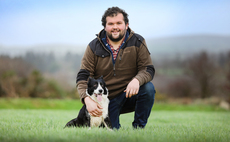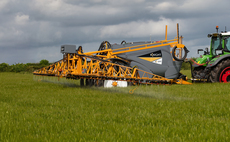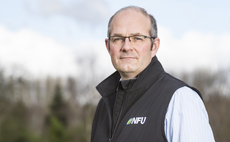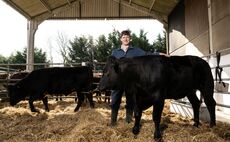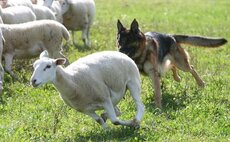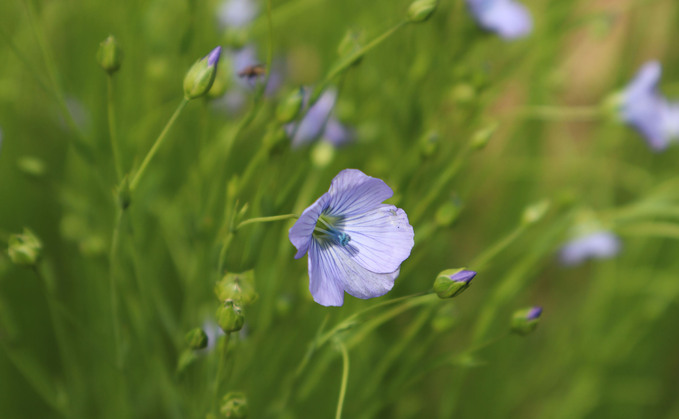
For hundreds of years, Scotland's farmers grew fibre flax for the country's textile and linen mills. But in the 1900s, cheaper imported textiles became popular and the entire industry eventually collapsed. Now, though, the focus on sustainability has led to a project which could see the high quality linen clothing produced from flax grown and processed in Scotland.
It is potentially a long road back, as Scotland's flax varieties have been lost after the final commercial crop was grown in the 1950s, and the last linen mill, which relied on imported fibre, closed about two years ago. However, Colleen McCulloch, who is co-ordinating the farming part of the project for Innovative Farmers, is optimistic about its future: as well as the potential to provide a home-grown, biodegradable textile, flax is a low input crop and great for pollinators.
"For farmers interested in diversifying their rotations with crops which are good for biodiversity and suit a regenerative or organic approach, flax fits really well.
"There is a growing interest in regenerative textiles and fashion - people are looking at linen and they can buy it in from Europe, but nobody grows it on a commercial scale here. So, there's a demand that farmers could meet, as well as flax fitting into low-input and regenerative rotations."
Project
It is a project which involves a wide range of participants; the James Hutton Institute, Edinburgh College of Art at the University of Edinburgh, Heriot Watt University, seeds and technical support provided by Elsoms Seeds, three trial farms and 25 smaller community trial sites.
While flax is still grown in the UK for its seed (sold as linseed or flaxseed), these short-stemmed varieties are not suitable for making linen as the fibre is too short. This year's Scottish trials (see panel - Growing the crop) are using three new long-stemmed fibre flax varieties from Holland, aiming to find out how they perform in cooler climates.
The plant grows well in a range of conditions but is known to thrive and grow tall in temperate climates and damp soil, which makes Scotland an ideal location, says Ms McCulloch.
The Netherlands and France, where 70 per cent of the world's fibre flax is still grown, have been useful sources of information, as have some farmers in Ireland, as the three growers in the trial strive to discover which varieties might work best in Scottish growing conditions.
Drilling
The plots were drilled in early April, either into a prepared seedbed or direct drilled, and flower after about 60 days, with harvest expected about 100 days after drilling.
"Flax for fibre is easy to grow and doesn't need any inputs.
"We had a few plots that required some mechanical weeding in the first few weeks, but that was quite straight-forward as it had been drilled in rows, and once the crop establishes it grows quickly and out-competes weeds," explains Ms McCulloch.
Harvest is quite different: The stem is the most valuable part, so the whole plant is pulled up rather than being cut. Once it is pulled up, it is laid flat on the ground in windrows and left to ‘ret' in the dew or rain for two to three weeks, being turned once or twice a week. The retting process helps break down the woody lignin in the stem, which is essential in order to get the fibre.
After retting, the crop is then hung to dry for two to three months before it is processed to make linen. This involves many steps, explains Ms McCulloch (see panel).
"Our part of the trial is growing, harvesting and retting the crop, but there are other projects who are working on the processing side."
Interested in alternative break cropping? Read more here: Exploring the benefits of alternative break crops
Research
Besides the three growers in the main trial, there is a parallel ‘citizen science' research project with more than 30 growers and groups across 25 community sites in Scotland trialling one variety to complement the growers' findings by broadening the range of growing conditions being tested.
"We would also really like to find people who have knowledge of the crop being grown in Scotland before, and to see if there is any surviving fibre flax seed anywhere; maybe in someone's shed?
"The field lab is a one-year trial, but the growers are looking to scale up and collaborate with a growing network of other businesses and organisations to establish a commercially viable Scottish linen supply chain in the longer term.
"There is a real appetite from people who are interested in growing it and those who are keen to use it. It would be great to have a revival of the Scottish linen industry again, and we are hoping to do bigger scale trials next year as we need to learn more," adds Ms McCulloch.
To find out more and to get involved, visit the field lab portal on the Innovative Farmers website.
Growing the crop
Flax triallist Jossie Ellis grows vegetables at Lauriston Farm, Edinburgh - a 40-hectare site that focuses on community engagement and biodiversity alongside food production.
She is providing flax for student research into developing the processing equipment needed to help bring this natural fibre back to the UK.
Ms Ellis says: "Flax used to be a really important part of the agricultural heritage in Scotland, but it's been completely lost. The field lab is helping us get a sense of how it performs as a crop, which is important because there must have been different varieties that were developed and grown in Scotland because it is well suited to this region. Finding the seeds that work here will help contribute to that wider work to bring this industry back to the local area."
At Lauriston Farm they are keen to test the crop's commercial viability and to engage the local community in home-grown fashion.
"We are growing our trial crop with no intervention. If the intention is to grow it at field scale, we want to see what our yields will be in that scenario and see how robust it is.
"It's also a really interesting crop to engage people on the farm. It's really pretty with lots of blue flowers, but there's something about it that people get excited about. It surprises them to realise that's where linen comes from - people don't expect their clothes to have come from a plant.
"There's growing awareness of the significant impact that cotton can have on the environment, and that industry is often very exploitative and highly extractive. It gets people thinking about growing in their everyday lives. It makes people realise that farms are for everyone, and we all have a reliance on the land in ways that we might not have considered."
Processing the crop
Scotland's last linen mill closed two years ago, making processing flax on an industrial scale a tricky prospect. Students at Edinburgh School of Art will be processing the flax they are growing as part of the project, while flax farmer and enthusiast Rosie Bristow is working on developing higher volume processing capabilities. Some farmers have also been approached by overseas processors seeking growers, as expanding the growing area is one of the aims of trade body, the Alliance for European Flax-Linen and Hemp.
Processing flax into linen is a lengthy task. Once crops have been subject to retting and then dried and baled, they are taken for further processing, the first stage of which is called scutching. This mechanical process separates the flax fibre from the woody stem. It then goes on to heckling, which is where the fibre is repeatedly combed to form soft, lustrous ribbons.
After this, it is prepared for spinning, a complex and skilled process, says the Alliance for European Flax-Linen and Hemp. It explains that in large-scale processing, heckled flax from different batches of fibres, grown on different fields and in different regions, and during different years, are blended together in order to produce a consistent yarn. This means that for European linen, each strand may contain flax from up to 32 different batches, it says.
Spinning
Spinning - either wet or dry - then transforms the flax into yarn by applying a twist and, again, blending to produce a consistent yarn quality. Wet spinning, which involves immersing the fibres in water heated to 60degC, works well for yarn used in clothing or household linen, while dry spinning creates rustic, thicker yarn for use in furniture and rope making.
Quality of yarn is defined by the number of kilometres of yarn per kilogram. The higher the number, the finer the yarn on a scale from Nm1 to Nm60, sometimes even reaching Nm100.
Yarns can be woven in different ways to create a fabric suitable for clothing, household linens and furnishings, or knitted, which gives linen more flexibility, elasticity and crease-resistance and is used mostly to make T-shirts and tops. One square metre of flax produces enough linen to make one tea towel.
Ms Bristow is working with a start-up fashion brand, First Principals, and together they have launched Fantasy Fibre Mill which ‘connects regenerative agriculture to ethical fashion, producing natural fibre yarn which is grown, processed and spun in the UK'.
She says: "So far we have grown a hectare of flax, built three prototype processing machines, made lots of yarn samples and undertaken a big research project into the viability of building a soil-to-soil textile economy in the UK."









